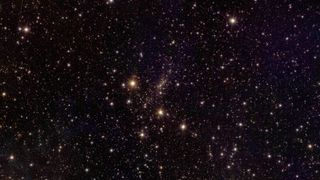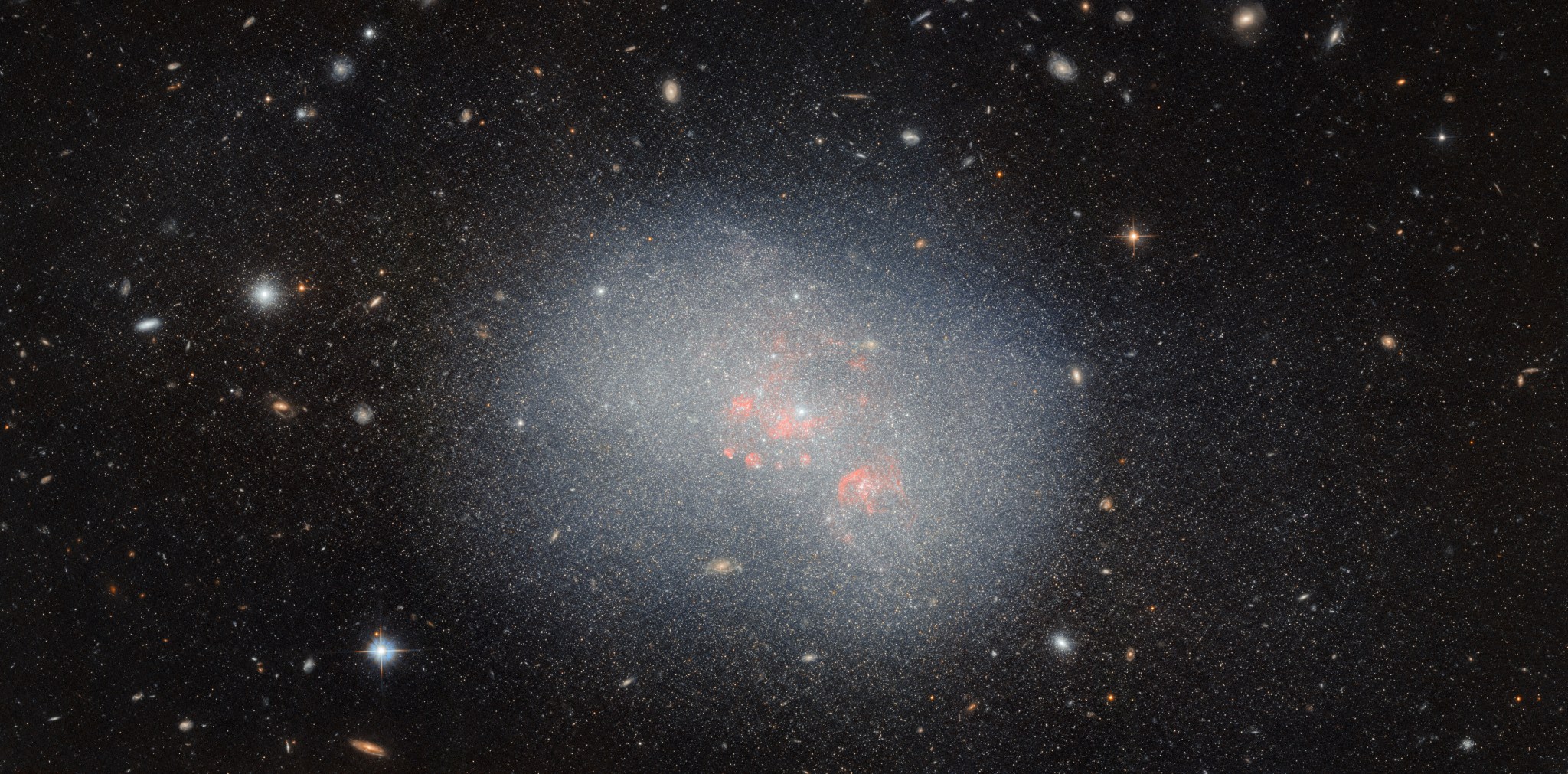The Hubble Space Telescope has uncovered an isolated cosmic fossil, which may offer new insight on galaxy formation. Located about 3 million light-years from Earth, the Tucana Dwarf galaxy sits at the far edge of the Local Group of galaxies, which includes our Milky Way galaxy. This galaxy is home to older stars, leading researchers to believe it may contain traces from the early universe, according to a statement from NASA. “Having such pristine properties enables scientists to use the Tucana Dwarf as a cosmic fossil,” NASA officials said in…
Read MoreTag: Galaxies
Hubble Zooms into the Rosy Tendrils of Andromeda
2 min read Hubble Zooms into the Rosy Tendrils of Andromeda NASA, ESA, M. Boyer (Space Telescope Science Institute), and J. Dalcanton (University of Washington); Image Processing: Gladys Kober (NASA/Catholic University of America) Clusters of stars set the interstellar medium ablaze in the Andromeda Galaxy about 2.5 million light-years away. Also known as M31, Andromeda is the Milky Way’s closest major galaxy. It measures approximately 152,000 light-years across and, with almost the same mass as our home galaxy, is headed for a collision with the Milky Way in 2-4 billion…
Read MoreHubble Pinpoints a Dim, Starry Mini-galaxy
The Pegasus Dwarf spheroidal galaxy, also known as Andromeda VI, is one of at least 13 dwarf galaxies that orbit the Andromeda galaxy. NASA, ESA, and D. Weisz (University of California – Berkeley); Processing: Gladys Kober (NASA/Catholic University of America) A glittering collection of stars shines against a background of much more distant galaxies in this view from NASA’s Hubble Space Telescope of the Pegasus Dwarf spheroidal galaxy, also known as Andromeda VI. The Andromeda galaxy, also known as Messier 31, is the Milky Way’s closest grand spiral galaxy neighbor,…
Read MoreHubble Reaches a Lonely Light in the Dark
2 min read Hubble Reaches a Lonely Light in the Dark NASA, ESA, C. Gallart (Instituto de Astrofisica de Canarias), A. del Pino Molina (Centro de Estudios de Fisica del Cosmos de Aragon), and R. van der Marel (Space Telescope Science Institute); Image Processing: Gladys Kober (NASA/Catholic University of America) A splatter of stars glows faintly at almost 3 million light-years away in this new image from NASA’s Hubble Space Telescope. Known as the Tucana Dwarf for lying in the constellation Tucana, this dwarf galaxy contains a loose bundle of…
Read MoreWill our galaxy really collide with Andromeda? Maybe not
Astronomers have long considered it inevitable that our home galaxy, the Milky Way, will merge with the neighboring Andromeda galaxy within the next 5 billion years. However, a new simulation suggests the chance of this clash happening comes down to a coin flip — at least, within the next 10 billion years. “I would say that the popular narrative is diminished, but not eliminated,” Manasvi Lingam, an astrobiologist at Florida Institute of Technology who was not involved with the new study, told Space.com. At about 2.5 million light-years from our…
Read MoreHubble Rings in a New Galactic View
This NASA/ESA Hubble Space Telescope image reveals the galaxy LEDA 857074. ESA/Hubble & NASA, I. Chilingari The subject of this NASA/ESA Hubble Space Telescope image is situated in the Perseus Cluster, also known as Abell 426, 320 million light-years from Earth. It’s a barred spiral galaxy known as MCG+07-07-072, seen here among a number of photobombing stars that are much closer to Earth than it is. MCG+07-07-072 has quite an unusual shape for a spiral galaxy, with thin arms emerging from the ends of its barred core to draw a near-circle around its…
Read MoreHubble Images a Classic Spiral
ESA/Hubble & NASA, C. Kilpatrick This NASA/ESA Hubble Space Telescope image treats viewers to a wonderfully detailed snapshot of the spiral galaxy NGC 3430 that lies 100 million light-years from Earth in the constellation Leo Minor. Several other galaxies, located relatively nearby to this one, are just beyond the frame of this image; one is close enough that gravitational interaction is driving some star formation in NGC 3430 — visible as bright-blue patches near to but outside of the galaxy’s main spiral structure. This fine example of a galactic spiral holds a…
Read MoreX-rays reveal secret gas in huge and distant galaxy cluster
By combining a new image of a giant galaxy cluster with older X-ray data, scientists at the European Space Agency (ESA) have demonstrated how the cluster’s galaxies are suffused by huge amounts of gas that can reach scorching temperatures up to 100 million degrees Celsius (180 million degrees Fahrenheit). The galaxy cluster, Abell 2390, was imaged recently by ESA’s Euclid mission, designed to study dark matter and dark energy by probing gravitational lensing occurrences in galaxy clusters. Because these clusters contain so much mass — up to ten trillion solar…
Read More25 Images to Celebrate NASA’s Chandra 25th Anniversary
NASA/SAO/CXC This montage contains 25 new images with data from NASA’s Chandra X-ray Observatory that is being released to commemorate the telescope’s 25th anniversary in space, as described in our latest press release. Since its launch into space on July 23, 1999, Chandra has been NASA’s flagship mission for X-ray astronomy in its fleet of “Great Observatories.” Chandra discovers exotic new phenomena and examines old mysteries, looking at objects within our own Solar System out to nearly the edge of the observable Universe. There is a broad range of astronomical…
Read MoreHubble Studies a Potential Galactic Merger
3 min read Hubble Studies a Potential Galactic Merger This NASA/ESA Hubble Space Telescope image captures the dwarf irregular galaxy NGC 5238. ESA/Hubble & NASA, F. Annibali This NASA/ESA Hubble Space Telescope image features the dwarf irregular galaxy NGC 5238, located 14.5 million light-years from Earth in the constellation Canes Venatici. Its unexciting, blob-like appearance seems to resemble an oversized star cluster more than a classic image of a galaxy. Its lackluster appearance belies its complicated structure, which is the subject of a great deal of research. As the image…
Read More








